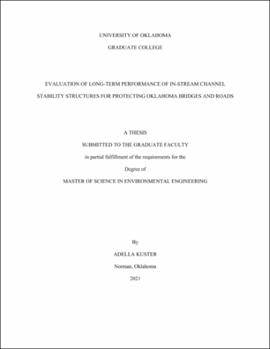| dc.description.abstract | Streambank erosion can damage bridges, hydraulic structures, and private property. In-stream structures may be installed to control river migration and limit bank erosion during large precipitation events. Historically, the structures most widely used by the Oklahoma Department of Transportation include Kellner jetties, rip rap, pile diversions, and bendway weirs. These structures each use different methods to decrease erosion and stream migration; therefore, their effectiveness may differ based on a variety of variables including stream geomorphology, site and watershed characteristics, and occurrence of extreme precipitation events. Many of these structures have been installed on Oklahoma rivers but have not been consistently evaluated.
Previously, two studies completed by the Oklahoma Department of Transportation and the University of Oklahoma in 1971 and 1989 have qualitatively evaluated the effectiveness of over 20 in-stream structures near transportation infrastructure. In this project, remote evaluations of the characteristics of the streams and watersheds, along with on-site stream surveys and geomorphological studies, were completed. This project augments and enhances the previous studies through quantitative analyses of the durability of the structures, stream characteristics, and stream geomorphology. Logistic regressions indicated that soil type and structure design impact the success of different structures. Pile diversions were more likely to fail on rivers with more sand, potentially due to the mobility of a sandy river bed. Kellner jetties failed more frequently with smaller angles between the stream flow line and the Kellner jetty lines. Overall, structures were more successful in streams with higher silt content in their bank material. This data can be used in the future for making decisions surrounding streambank stabilization projects in Oklahoma. The results of this study provide a unique opportunity to optimize the likelihood of successful implementation of in-stream structures in rivers with varying characteristics. | en_US |

